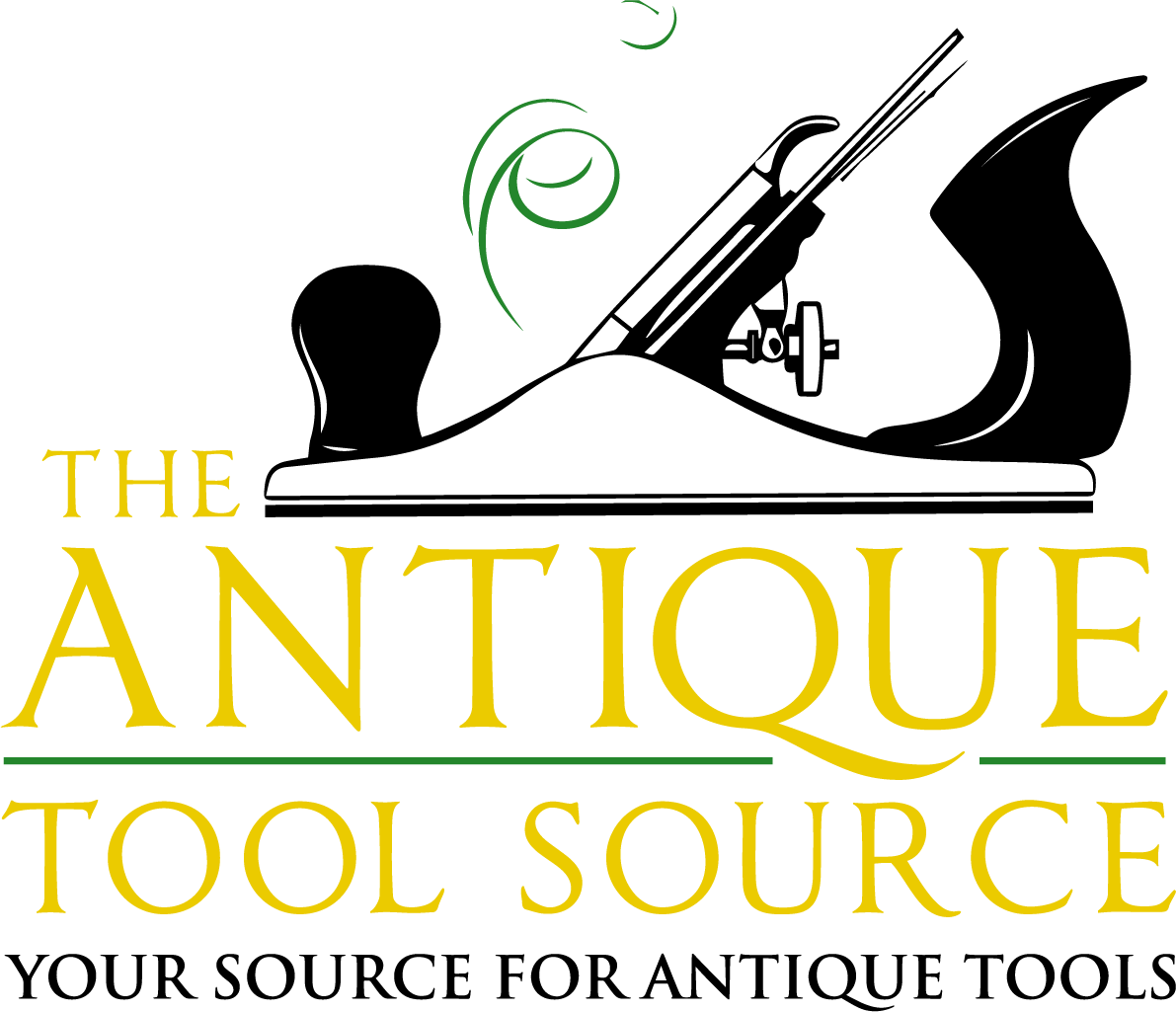THE WHEATCROFT BOYS Edward & George of Newark, New Jersey
THE WHEATCROFT BOYS Edward & George of Newark, New Jersey
Newark, New Jersey was an industrial center in the early 19th century with a population of 11,000 souls in 1830. Many varied manufacturers produced all sorts of goods for the young United States of America in this growing city. Our focus in this article is the tool manufacturing brothers, Edward and George Wheatcroft.
The two boys were born in England, possibly the sons of John Wheatcroft of John
Wheatcroft & Sons, Sheffield. Nothing could be found concerning their childhood
years. The story begins when thirty four year old Edward immigrated to New
York City in 1833 aboard the ship Hogarth out of Liverpool. With him was his 32 year old wife, Martha and three sons, Henry, Edward and Joseph.
Edward’s younger brother, George, followed on the ship John Jay in 1834 at twenty three years of age and unmarried. They moved to Newark, NJ soon after arriving in the US. Both men seemed to have been apprenticed in the family tool making trade.

Photo 1
Rare Beech Plated Brace Made By George Wheatcroft
From collection of Bob Garay
Interestingly, Edward’s wife, Martha (Belcher) Wheatcroft, was the daughter of Zachariah Belcher , founder of Zachariah Belcher Rule Makers, 1 Bright Street in Sheffield, England, founded in 1792. Martha was the sister of Thomas, William and Charles Belcher, sons of Zachariah Belcher, and founders of Belcher Brothers, rule manufacturers, first located in New York City and then Camptown (Irvington), NJ. The Belcher Brothers continued to maintain sales offices in New York City. It seems that a business relationship would continue between the Wheatcrofts and Belchers for years to come.
From the time of their arrival in America until 1839 no historical information could be found concerning the businesses of Edward and George. In 1839 the Newark City Directories listed Edward Wheatcroft as a plane manufacture located at 3 Sheffield Street. Between 1839 and 1849 Edward moved several times ending up at 138 State Street where he would remain. He was listed variously as a maker of mason trowels, ship scrapers and carpenter tools. It appears that he left the tool making business around 1855 – 1860 and became a clerk and then an agent for, or possibly a manufacturer of, “Fancy Steel & Glass Goods.” It has been suggested that Edward went on to be part of the Belcher Brothers diversified companies.
Charles Belcher had established a successful stained glass business around this time.
George Wheatcroft was first listed in the Newark City Directories in 1840 as a maker of carpenter tools. He was located at the Washington Factory, 389 Broad Street, later to be known as the Hedenberg Works in 1847. Hedenberg Works was an industrial building complex in Newark, occupied by many manufacturers including the tool maker, William Johnson. George moved twice between 1843 and 1845. He was married to Ann Hatcraft of Newark on November 17, 1844.
George returned to Washington Factory where he remained until he died on August 17, 1860 at 49 years of age. He was survived by his wife, Ann. George is much better known than his brother, Edward, and his tools are more plentiful.
Alexander Farnham (See bibliography) states that William Belcher sold marking, cutting and mortice gauges made by George Wheatcroft. After George’s death there was a recorded inventory of his estate which included consigned tools in the hands of Wm. Belcher and other sellers. See photo 2.
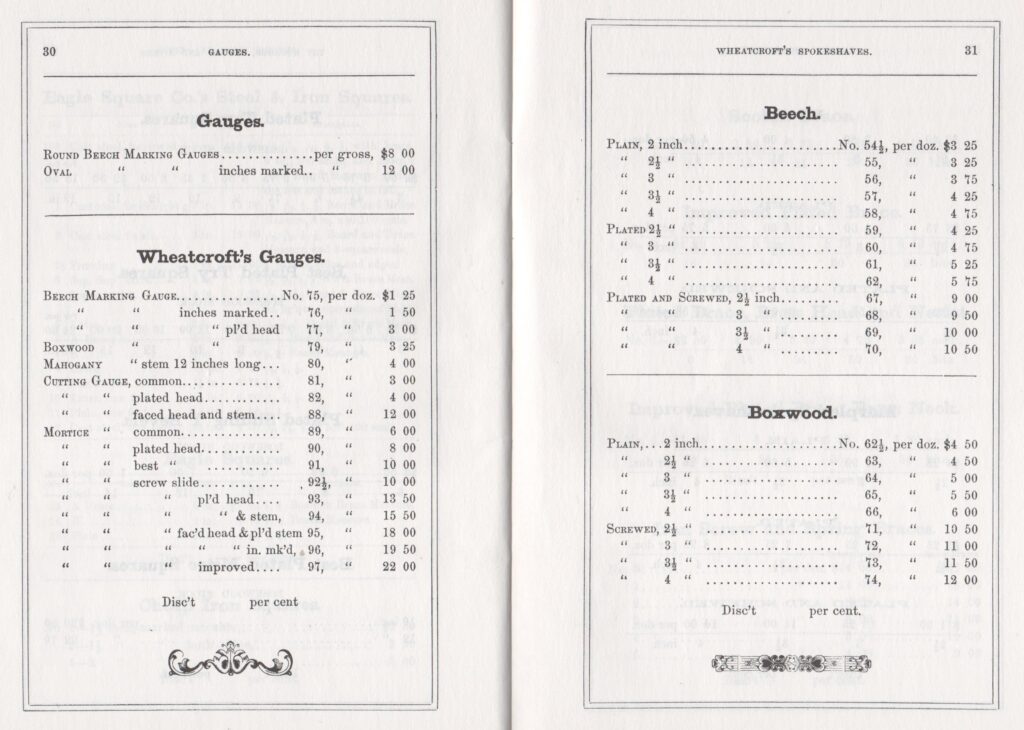
Photo 2
Belcher Brothers & Co. Price List of 1860
No information about the brothers has been found for the period of 1834 until 1839 when they began to be listed in the city directories. However, there is plenty of evidence that they were busy together in a partnership manufacturing tools.
Although no official record can be found of a partnership the tools themselves bear testimony of one.
The stamp, E & G Wheatcroft, Makers, can be found on a number of tools still extant. (See Photo 3)

Photo 3
In my collection I have two mortise gauges, one marking gauge and a spoke shave with this maker mark. I’ve seen offerings in a number of auction listings for tools by this partnership including a Horst Auction Center, Summer 2014 tool sale that listed Lot 317, “Wedge arm leather slitting gauge with good deep set trademark on side of oval fence.” The two mortise gauges mentioned above are of the stuffed brass frame, “Ultimatum,” style found in England. (Photo 4)

Photo 4
Both have slotted fixing and adjusting screws used to operate the gauges. These men, fresh off the boat from England, made gauges in the English style to which they were familiar. As the years went by their gauges became similar to the American style. It is interesting that there appears to be more tools of the E & G partnership available to us than examples of Edward Wheatcroft’s work while he was in business by himself. I am in possession of three of Edward’s tools, two rosewood mortise gauges and a large rosewood handled square with an 18 inch blade. (Photos 5, 6 & 7)

Photo 5
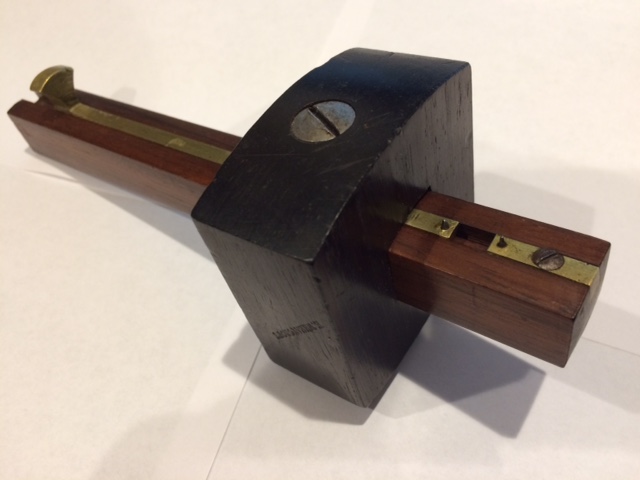
Photo 6

Photo 7
Edward’s tools have been disparaged by some, as inferior in quality, since there are so few of them to be found. However, in my estimation they are equal in quality to that of any other tool manufacturer of his day. One reason for the small number of his tools could be that they are often missed due to the small and innocuous size of his maker’s stamp. The letters are 1/16” tall and make a shallow mark which is difficult to read. It simply reads, E.WHEATCROFT and can be confused with an owner’s stamp. Also, his marks are often overstamped with owner marks. Even so, his tools do come up occasionally but are quite rare. (Photo 8)

Another reason that so few of Edward Wheatcroft’s tools are found is that he was involved in other pursuits in addition to tool making. The Belcher brothers moved their rule factory to Camp Town, NJ in 1843. It is reported that the machinery in this facility was powered by water. The water and mill works were designed and managed by none other than Edward Wheatcroft. This is not surprising since his immigration papers list him as a miller. He remained a very important member of the Belcher family both socially and in business. An obituary has been found for Edward Wheatcroft. It states that he died August 28, 1868 at 66 years of age. (The age listed does not agree with his immigration age and date by three years but other information in the obituary is correct.) His wife, Martha, born 1805 died in 1880 at 75 years of age.
A number of articles have been written about the quality of George Wheatcroft’s tools. He exhibited braces in the Philadelphia Franklin Institute’s fairs from 1850 to 1853. His braces showed improvement each year of submission. His tools are of a high quality and once you are able to examine one of his braces that quality would become readily apparent. (See Photo 1, Above) George’s marking and mortise gauges are fairly plentiful. (Photo 9) I have a dozen of them in my collection including an early one with some English features. (Photo 10)
Photo 8
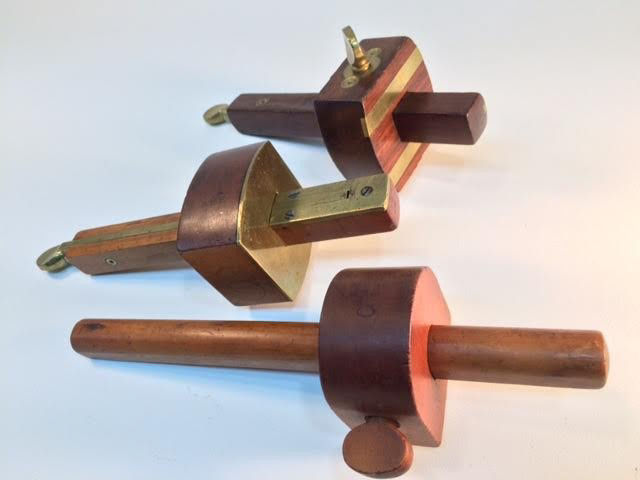
Photo 9

Photo 10
George used two different maker marks in his career. The earlier mark is larger with three straight lines, GEO. WHEATCROFT, line one, NEWARK, line 2 and NJ, line 3. (Photo 11) The second and most recent mark is tiny with letters in an upper arch, GEO.WHEATCROFT, a straight line under that, NEWARK-N.J, and a lower arch, WARRANTED. These letters are less than 1/32” tall and the entire stamp is only 5/8” wide. (Photo 12)

Photo 11

Photo 12
( Additional tools by George Wheatcroft shown below.
Collection of Chuck Grannick )
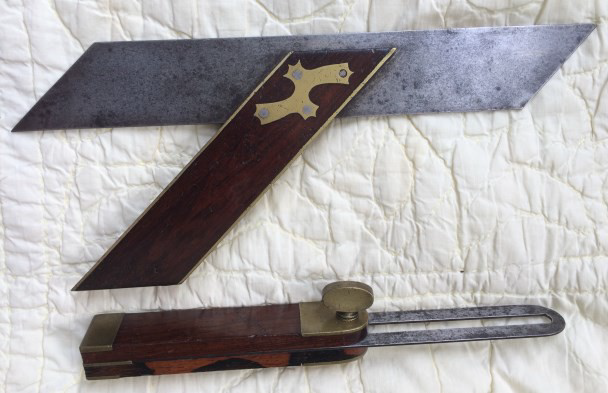
Photo 13
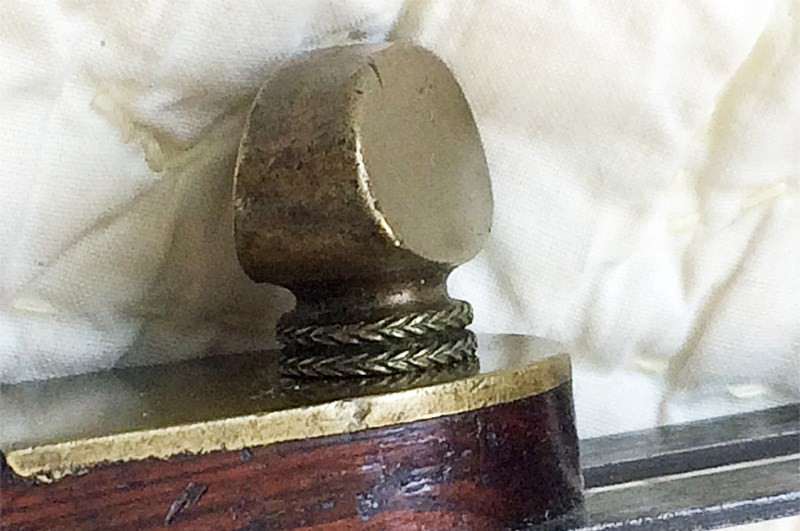
Photo 14
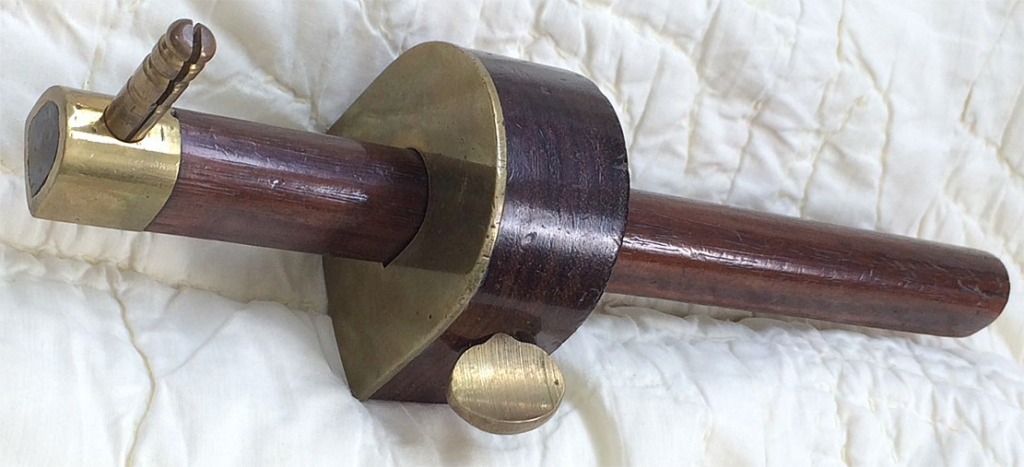
Photo 15
Alexander Farnham states that both Edward and George were making planes in the 1840s and the city directories list Edward as a plane maker. However, I have never seen a plane marked by either man. Thomas Elliott’s book, A Guide to the Makers of American Wooden Planes, 5th Edition, does not list any recorded plane maker marks for either brother. There could be an explanation for that lack of history but I’m not sure what it would be except a very small production of planes by either man. If anyone has additional information to share about these two men please feel free to contact the author.
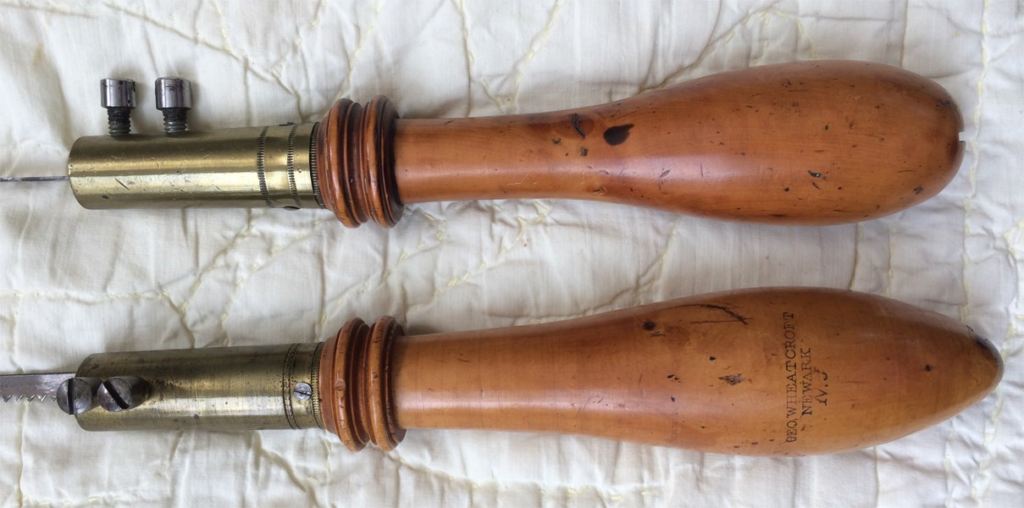
Top pad saw made by E&G Wheatcroft, the bottom saw is by George Wheatcroft.
From collection of Chuck Grannick.
By the late 1860’s the doors of both manufactories were closed and the lights out.
The end of an era. But the memory of both men live on in the tools we find and cherish! Enjoy!
Some of the information for this article is from observation of the tools available.
Information was also found in:
Early Tools of New Jersey and The Men Who Made Them by Alexander Farnham
Copyright 1984 American Marking Gages Patented and Manufactured by Milton Bacheller, Jr. Copyright 2000 My Ruling Family-The Belcher Brothers & Cos. By Charles Zachary Belcher Copyright 2013 The Tool Shed Number 15, January 1981, Journal by CRAFTS of New Jersey Belcher Brothers & Co.’s, Price List of Boxwood & Ivory Rules, 1860
(Kenneth D. Roberts Reprint, September 1982)
Jim Fox is retired and lives in St. Cloud, FL with his wife, Candy.
foxyjim1940@gmail.com
